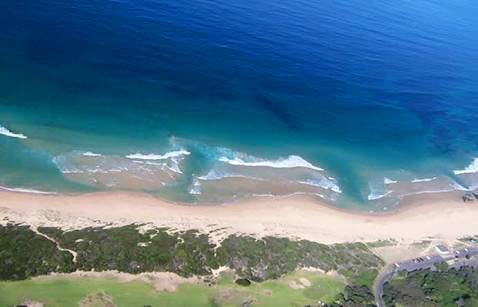As a former surf lifesaver I constantly find myself when I'm at a beach automatically in patrol mode, and I'm always troubled seeing the amount of people that enter the surf straight into a rip zone. This includes, and most worrying of all children. I know a lot of people are kind of aware of what to do if caught in a rip, but it has been brought to my attention recently that a lot of people aren't aware of what a rip actually looks like or where the safest place to swim at the beach is if there is no flagged area.
One person will drown every two to three days this summer... 90% of those fatalities will be rip-related. Here are a few things that will help you and your kids stay safe this summer. I have also put together a few images that show what to look for.
1. The easiest thing to remember is that often the safest/calmest most enticing looking area along a beach is usually a rip. A rip is usually the area devoid of wave activity and appears darker and deceptively calmer. It can sometimes appear milky or turbulent, but it is always pretty much void of wave activity. All that water coming in via waves has to go back out somehow, this is what a rip is. (see pics).
2. Always take 5-10 mins when you get to the beach to observe surf conditions and identify where these areas are.
3. If you are caught in a rip, DO NOT PANIC. Go into floating mode and raise one arm as a distress signal when possible. See which direction the rip is taking you, is it straight out or at an angle? once you have determined this, and if you have the energy, swim to the right or left of the direction of flow, never against. Some rips can move at 3 times the speed of an olympic swimmer, you won't win! If you cannot swim out to either side of the rip, just go with it. Most rips won't take you out very far, and will usually spit you out not long after they take you, so keep calm and save your energy for the swim back to shore.
4. If you have kids, show them these pictures, educate them and make them aware. You can't always be watching them, and it is only a matter of a few metres each way of the point of entry to the water that could mean them being safe, or instantly caught in a rip.
Obviously the safest place to swim is always between the flags on a patrolled beach, but this isn't always practical given the immensity of our coast line and number of beautiful beaches. Of course there are many other factors that can come into play when it comes to beach safety, but rips are the No.1 killer. They are not hard to identify, and 10 mins observation before entering the surf is much easier than body retrieval.
*The darker/calmer areas in the pics are rips. The one with purple dye shows rip movement.










No comments:
Post a Comment
Thank you. Comments are welcome.
ivan